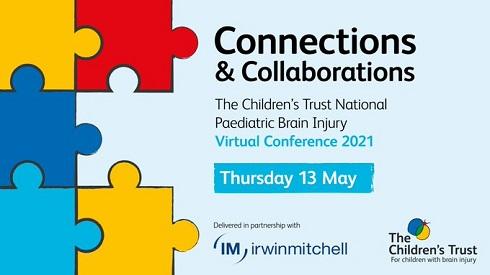
Published on: 17/05/21
We share 5 learnings from Connections & Collaborations, the national paediatric brain injury conference.

Published on: 17/05/21
"Parents become 'project managers' for the support the child needs, while siblings become the 'young carer'," said Gerard Anderson, Head of Brain Injury Services, Child Brain Injury Trust, speaking on the social and emotional impact of lockdown on family recovery post acquired brain injury.
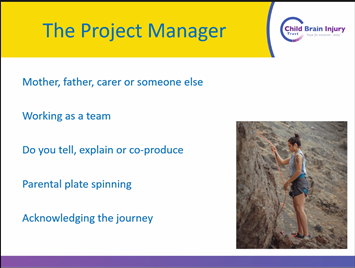
Gerard's session covered the support families need at all times – but expressed how this has been heightened in a global pandemic with services evolving faster, and challenges for community services, which has put even more pressure on the parents' role.
One of Gerard's key messages was how working as a team can have a massive impact on the family, asking the audience if they 'tell', 'explain' and 'co-produce'? He explained that this doesn't just apply to the parents and siblings, but also the child themselves.
Preparing the 'project manager' to effectively rehab their child after their illness is key and Gerard used an analogy to step into the family’s shoes: "Our brains are like filing cabinets with everything we say and do in right file in the right drawer. Rehab is about putting files back in right drawer in the right order. The process of tidying can take days, months, years – sometimes they don’t ever go back in the right place. How much easier would to be to reorganise if the owner of the filing cabinet had a say?"
Early intervention and continuity of care post-discharge was cited, as Gerard explained how scaffolding is key, building support around the child until the time it can be slowly removed.
It was emphasised that the hospital discharge letter and the rehab prescription (if given) were some of the most important documents, and how effective communication was key throughout. Gerard said: "Brain injury is a family affair and it takes the whole family, and the network around the family, to assist in the recovery. Empower families from the beginning."
Mental health and suicidal feelings were covered by Dr Louise Owen, Principal Clinical Psychologist, The Children's Trust, and 16-year-old Annabee, who sustained a traumatic brain injury when she was 14 years old.
The rise in suicide in children and young people over the last 10 years was noted, and Young Minds have noted the rise in loneliness and isolation in young people since the pandemic.
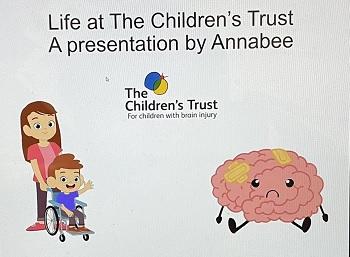
Annabee explained: "I am working on making mental health a topic that is widely spoken about and sharing strategies that have helped me."
Annabee explained how before her brain injury she 'didn't know what feelings were – they were non-existent to me and I didn't connect with them'. However, through her rehabilitation at The Children's Trust, which focused on her mood and how she shows emotions, Annabee learnt 'strategies to cope' and 'how to be confident again'.
Louise explained how Annabee's therapeutic work used a resiliency framework – the three factor model of personal resilience (Prince-Embery 2006). This focused on the therapeutic relationship; narrative approaches – externalising the emotions 'Numpty' and 'Smarty'; and a toolkit of coping strategies – ‘goodbye Numpty, hello Smarty!’.
Initially, Numpty, the down influence on Annabee, was more influential and powerful than Smarty, and took charge. But Smarty survived and Annabee learnt how to control Numpty creeping back into her life.
Through rehabilitation, Annabee learnt to find her emotions and work out what made her feel certain ways. The rehab also focused on Annabee's social interactions, helping her connect with people and develop authentic attachments with school, family and local services.
Annabee added: "In my free time, I also learnt many things. I learnt how to talk to people, how to have fun and how friendships work. Many achievements were also made including running on a treadmill for an hour; doing work experience; showing my artwork to an artist; and making friends."
Louise explained how, while at The Children's Trust, Annabee was supported in developing self-awareness around her feelings and identifying her strengths; working on her identity and who she is; communicating and feeling more supported by your system; self-control and self-agency (recognising when Numpty is on the way); and empowering your voice to be heard.
Annabee said: "Being at The Children's Trust was a starting point to a better way of life."
"Therapies need to be motivational and bring out the child into active participation," said Dr Andreas Meyer Heim, Chief Medical Officer of the Rehabilitation Centre, University Children’s Hospital in Zurich.
Andreas explained how rehab needs to be performed in an enriched environment and how, in Zurich, they have introduced novel technologies in paediatric neurorehabilitation. A recent example included piloting a mobile app to enhance an enriched environment and reward children in their efforts in therapies.
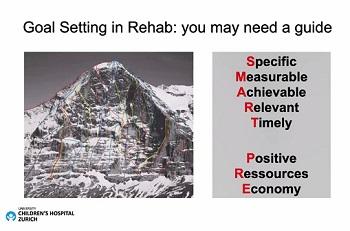
At the centre in Zurich, robotic-assisted gait training (RAGT) has been used since 2005 and has been increasing ever since. Andreas noted the significant increase in the number of papers citing technology in paediatric rehab from 889 hits in 2016 to 5000 hits in 2021 (January).
Andreas discussed the importance of individual goal-setting and said: "I cannot emphasise enough the importance of individual and specific goal setting… there are different routes to the summit of this mountain, we have to find the right one for each child individually." He explained that goals can use the SMART acronym; and noted that goals and expectations are not the same.
The role of particular technologies and their part in both in physical and cognitive rehabilitation was covered – examples included Andago and RAGT.
Explaining how a child can be immersed in their therapy, Andreas said: "The role of experienced therapists is to determine what games are most appropriate to the child". He used the example of a game where a child was equipped with a magical wand, and by using it the child could influence the course of the story. Benefits of Exergame, and extended or virtual reality (VR), were also covered including hand-eye coordination, sensory-motor training, strength training and balance.
Andreas advised: "Involve children in therapies and ask them their preference on full VR or mixed reality options." He then showed how by developing VR scenery, the child could participate in walking, stepping, collecting/eating and orienteering activities.
Robotic and VR therapies were recommended as complementary to conventional therapies – Andreas noted 'it is not an either/or' and continued: "We have to merge therapy contents into activities of daily living. We have to use them creatively and wisely."
Andreas added: "Some therapies are very creative and you can use Wii systems and make therapies motivational," making it clear that therapy can take place without specialist equipment.
In the next session, Charlie Danger, Advanced Assistive Technology Practitioner, and Marc Viera, Assistive Technology Practitioner, The Children’s Trust, covered the strengths and challenges for gaming interventions following a brain injury. The theme followed Andreas’ talk on providing activities that really motivate the child.
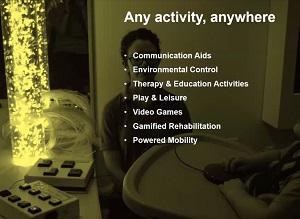
Again, it was cited this is not limited to specialist equipment and that tech is available from mainstream vendors like Amazon and Microsoft. Charlie said: "Assisted technology can benefit children and young people (CYP) onsite in any activity, not just for accessing a computer, or specifically about mobility. What we want for our CYP is to choose an activity they want to do, and we will help them with assisted technology."
Charlie explained how you can 'embed and integrate technology into therapy, education, play and leisure'. He said: "There isn’t really any limit except imagination – and asking questions of how assistive tech can help."
It was noted that there are barriers to break down in this area, such as challenging assumptions that computer games on an Xbox needed to be adapted, when in fact we can use such games to rehabilitate people’s cognition or movement.
The benefits of finding adapted methods to help a child re-engage with gaming, through something like the Xbox Adaptive Controller, were cited. However, Marc noted that you need to be mindful of the individual and their previous gaming experience and question whether they are ready to face that they are not going to be at the same level in the game they were before.
Marc advised: "With gaming and teenagers you have to be prepared about how you go about this – if the child having rehabilitation feels you are dumbing this down you may get immediate disengagement if you lose their trust, so you need to come in authentically with the right level. When you’re introducing a familiar activity, think about what that could do to their mood when they’re not successful at something they used to be good at."
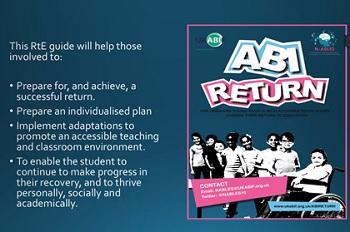
A key recommendation from UKABIF’s All-Party Parliamentary Group on Acquired Brain Injury is that 'All education professionals should have a minimum level of awareness and understanding of acquired brain injury, and the education requirements of children and young people with this condition'.
As steering group members of N-ABLES (The National Acquired Brain Injury in Learning and Education Syndicate), Dr Gemma Costello and Dr Emily Bennett explained how the organisation has developed and launched guidance for teachers – and how The Children’s Trust has launched a brain injury awareness programme for teachers.
Citing the need for such initiatives, Dr Emily Bennett, Consultant Clinical Neuropsychologist, Nottingham University Hospitals NHS Trust, said: "Many children have been falling under the radar and not received the report they require in school. One child in every classroom will experience an ABI and in areas of higher deprivation these figures are likely to be higher."
Returning to education after ABI was described as very challenging for the child or young person, their family and often the professionals involved too. It was noted how schools are crucial to help children and young people relearn skills and learn to compensate for acquired difficulties. The importance of professionals working with children and young people to recognise the role played by schools/education was considered – and helping them to get support right.
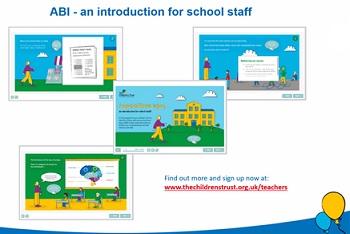
Dr Gemma Costello, Head of Psychosocial Services, The Children’s Trust, explained how the new N-ABLES guidance has been developed to show what the return to school could look like and provide a framework to help prepare for, and achieve, a successful return. The resource includes information on hidden needs and checklists to help support.
The Children Trust's information programme to improve brain injury awareness in schools was also launched and it was explained how this will support school staff in understanding what a brain injury is; how it could impact a child and their learning; and help staff know where they can go for information and support.
Gemma said: "Learning more about ABI will help teachers form a crucial link between the school and parents of a child with brain injury, working together to support their rehabilitation. Schools want this information – and having it helps them understand what their role is."
The important of Education Health Care Plans was covered by Irwin Mitchell with the care plan described as a 'detailed operational plan' that should identify the child's care needs and the provision needed to meet those needs. Oliver Studdert, Partner, and Steven Baylis, Senior Associate Solicitor, Irwin Mitchell also explained how it should set out who is to support what needs, where and when.
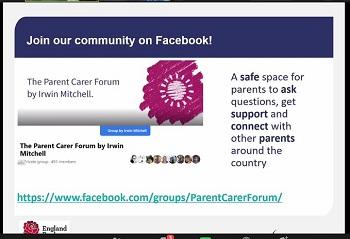
The detail of 'what a good assessment should look like' was covered with the speakers citing that 'High quality assessments should be child-centred, involve children and their families, be multi-agency and lead to action and the provision of services.' It explained the three phases for under 18s being assessment, decision-making and development of the care package.
The importance of a well-drafted and detailed EHCP plan was emphasised. And the support a child may need as they transition to adulthood and adult services was also identified. With ECHPs being such a complex area, Irwin Mitchell also shared their Parent Carer Forum where parents can get support and ask questions on such issues, connecting with other areas around the country.
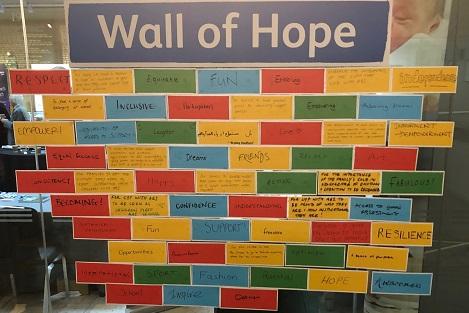
The National Paediatric Brain Injury Conference 2019 run by The Children’s Trust took place on Friday asking ‘where do we go from here?’. We share lessons learnt.
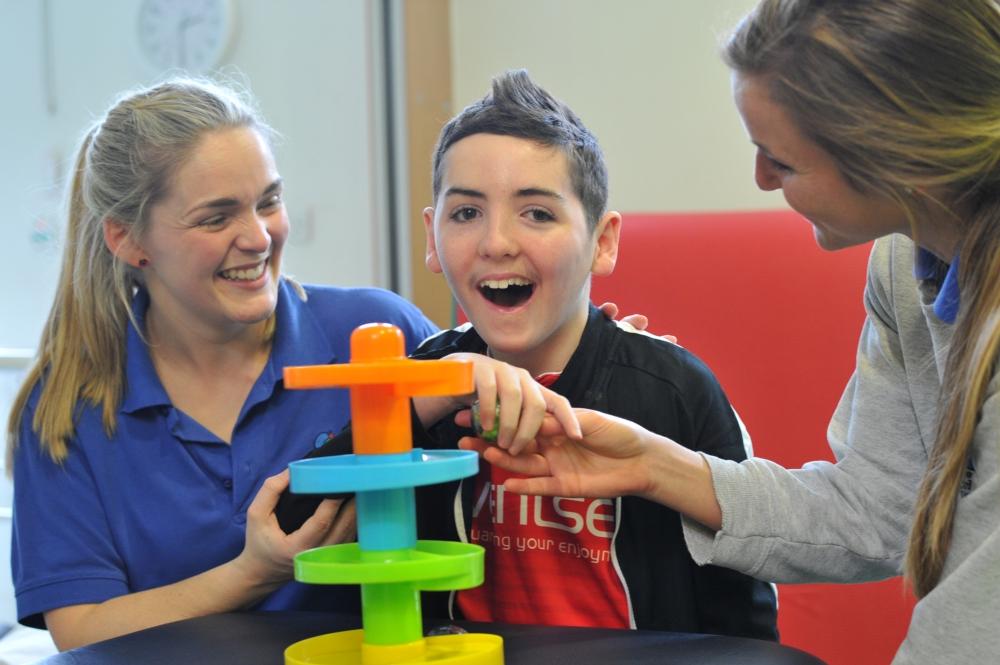
The Children’s Trust gives children and young people with brain injury and neurodisability the opportunity to live the best life possible by providing specialist rehabilitation, education and community services across the UK.